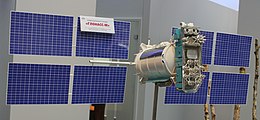 Glonass-M satellite model | |
| Mission type | Navigation |
|---|---|
| Operator | Russian Aerospace Defence Forces |
| COSPAR ID | 2014-032A[1] |
| SATCAT no. | 40001[1] |
| Website | GLONASS status |
| Spacecraft properties | |
| Spacecraft | GLONASS No. 755 |
| Spacecraft type | Uragan-M |
| Manufacturer | Reshetnev ISS[2] |
| Launch mass | 1,414 kilograms (3,117 lb) [2] |
| Dry mass | 250 kg[2] |
| Dimensions | 1.3 metres (4 ft 3 in) diameter [2] |
| Start of mission | |
| Launch date | June 14, 2014, 17:16 UTC |
| Rocket | Soyuz-2-1b/Fregat[2][3] |
| Launch site | Plesetsk 43/4 |
| Contractor | Russian Aerospace Defence Forces |
| Orbital parameters | |
| Reference system | Geocentric |
| Regime | Medium Earth orbit |
| Semi-major axis | 25,519 km (15,857 mi)[1] |
| Eccentricity | 0.0005[1] |
| Perigee altitude | 19,129 km (11,886 mi)[1] |
| Apogee altitude | 19,153 km (11,901 mi)[1] |
| Inclination | 64.77 degrees[1] |
| Period | 676.18 minutes[1] |
| Epoch | 15 June 2014 |
Kosmos 2500 (Russian: Космос 2500 meaning Space 2500) is a Russian military satellite launched in 2014 as part of the GLONASS satellite navigation system. It was the 2,500th satellite to receive a Kosmos designation
This satellite is a GLONASS-M satellite, also known as Uragan-M, and is numbered Uragan-M No. 755.[3]
Kosmos 2500 was launched from Site 43/4 at Plesetsk Cosmodrome in northern Russia. A Soyuz-2-1b carrier rocket with a Fregat upper stage was used to perform the launch which took place at 17:16 UTC on 14 June 2014. The launch successfully placed the satellite into a Medium Earth orbit. It subsequently received its Kosmos designation, and the international designator 2014-032A. The United States Space Command assigned it the Satellite Catalog Number 40001.[1]
The satellite is in orbital plane 3, in orbital slot 21.[4] As of August 2014 it remains in operation.
- ^ a b c d e f g h i Cite error: The named reference
n2yowas invoked but never defined (see the help page). - ^ a b c d e Cite error: The named reference
tsenkiwas invoked but never defined (see the help page). - ^ a b Cite error: The named reference
sfnwas invoked but never defined (see the help page). - ^ Cite error: The named reference
GLONASSwas invoked but never defined (see the help page).